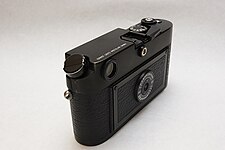Leica M6
The Leica M6 is a rangefinder camera manufactured by Leica from 1984 to 1998, followed by the M6 "TTL" manufactured from 1998 to 2002.[1] In 2022, Leica introduced a new camera based on the technology of the Leica MP but staying true to the design of the M6.[2]
Overview
1984
Interchangeable lens
36mm x 24mm
ISO 6-6400
Manual setting
Manual
Manual
Split and superposed-image rangefinder
Manual (M), and Bulb (B)
Center-weighted (13% of full film format)
1/50s
Mechanically timed horizontal running cloth shutter
1s - 1/1000s with Bulb and 1/50s flash sync
Brightline frame viewfinder with automatic parallax-compensation
0.58x, 0.72x, 0.85x
3v from 2x PX76/SR44 silver oxide cell or 1x DL 1/3N lithium cell
Leica Motor-M, Winder-M, Winder 4-P and Winder 4-2
138 mm × 77 mm × 33.5 mm (5.43 in × 3.03 in × 1.32 in)
585 g (20.6 oz)
Germany
The M6 combines the silhouette of the Leica M3 and Leica M4 with a modern, off-the-shutter light meter with no moving parts and LED arrows in the viewfinder. Informally it is referred to as the M6 "Classic" to distinguish it from the "M6 TTL" models, and to indicate its "Classic" M3 dimensions. The top and bottom plates were made from lighter, cheaper magnesium alloy rather than the heavier machined brass of the M3 and M4. The M6 and M6 TTL are mechanical cameras; all functions except the light meter work without batteries, unlike the succeeding M7, which needs electrical power to operate properly.[1]

